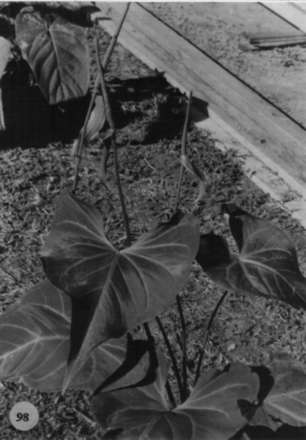




Anthurium leuconeurum Lem.,
111. Hort. 9, PI. 314. 1862. TYPE: The description is based on a plant from southern Mexico collected by Ghiesbrecht and cultivated in Ghent, Belgium, by Ambr. Vershchaflelt; the illustration in 111. Hort. (9: 5.314. 1862) serves as the type.
Terrestrial; stems and internodes very short; cataphylls moderately coriaceous, acute at apex, persistent.
LEAVES erect-spreading; petioles 30-70 cm long, 4-7 mm diam.,
terete or weakly sulcate adaxially, the blades held parallel to petiole;
geniculum 1.5-3.5 cm long; blades narrowly ovate to ovate; abruptly acuminate
at apex, deeply lobed at base, (12)20-38 cm long, (8)12-29 cm wide, broadest
at point of petiole attachment; the anterior lobe (8) 14-28 cm long; posterior
lobes (2.5)6-13 cm long, directed toward base; the sinus obovate to hippocrepiform,
rounded at apex;
the upper surface velvety, dark green, the lower surface much paler;
midrib and basal veins flat to weakly sunken above, much paler than surface;
the area on either side of the veins paler than rest of blade; basal veins
5-6(7) pairs, at least the third and fourth coalesced 1-4.5 cm, arcuate-ascending,
the second and sometimes the third joining the margin well above the middle
of the blade; the posterior ribs straight to gradually curved, naked (at
least on the larger blades); primary lateral veins 3-4 per side, departing
the midrib at an acute angle, then gradually curved toward the margin,
loop-connecting with collective vein; collective vein arising from the
first basal vein or sometimes one of the lowermost primary lateral veins,
0.7-1.4 cm from margin.
INFLORESCENCE erect, at least as long as leaves; peduncle 40-68
cm long, 4-6 mm diam., terete; spathe narrowly ovate to ovate-lanceolate,
green, 4.5-10 cm long, 1-2.5(3.5) cm wide, broadest just above base, narrowly
acuminate at apex, weakly cordate and clasping at base, inserted at ca.
20° angle on peduncle; spadix sessile or nearly so, green, (4)6-13
cm long, 6-8 mm diam. at base, 4-5 mm diam. at apex; the flowers rhombic,
3.8-4 mm long, 3-3.5 mm wide, the sides straight parallel to spirals, smoothly
sigmoid perpendicular to spirals; 6-7 flowers visible in the principal
spiral, 4-5 flowers visible in the alternate spiral; tepals sparsely punctate,
lateral tepals 2.1 mm wide, the margin broadly rounded, thin and turned
up against pistil; pistils elevated but not emergent until after anthcsis
of stamens;
the stigma 0.5 mm long, elliptic, slitlike; stamens emerging in a prompt
sequence from the base, the stamens in the basal one-third complete before
the alternates emerge in the apical one-third; anthers held above lepals
and over pistil but not obscuring stigma, 0.9 mm long, 0.8 mm wide, evenly
spaced; thecae oblong-elliptic, scarcely divaricate.
INFRUCTESCENSE pendent; berries broadly obovoid, rounded at apex,
bright orange, 9-10 mm long, 8-10 mm diam.; pericarp moderately thick,
with dense raphide cells; seeds 2, narrowly obovoid to obovoid, brown(?),
slightly flattened, 6-7 mm long, 5-6.5 mm wide, 3.6-4 mm thick. Fig. 98.
Anthurium leuconeurum was collected in southern Mexico in about
1860 and apparently has not been recollected in the wild. All known herbarium
col lections are from living collections, presumably derived from the original
living collection in Belgium. If the species still exists in the wild it
is surely a narrow endemic similar to A. clarinervium.
I have strong suspicions that A. leuconeurum represents a
plant of hybrid origin, probably offspring of A.
berriozabalense and A. clarinervium. This cross has been
made by Banta [see Aroideana 6(1); 26-27. 1983] and the resulting hybrid
looks much like the type drawing of A. leuconeurum.
The species is a member of section Cardiolonchium and
is characterized by having a velvety leaf blade with usually paler major
veins similar to A. clarinervium, to which it is apparently related.
It is distinguished from the latter species by its generally larger and
more narrowly ovate leaves that have the basal veins coalesced into a naked
posterior rib, 1-4.5 cm long. Anthurium clarinervium generally has
the basal veins free or if they are coalesced the posterior rib is never
naked.
Engler (1905) cites Ghiesbreght (1877) (note difference in spelling).
It is not certain whether this is his collecting number or not but it implies
that he saw an actual specimen. If so, it is unlikely that the specimen
still exists. Anthurium leuconeurum was the subject of much hybridization
after its introduction into Europe in the early 1860s. Perhaps the most
well known of these hybrids is A. macrolobum Hort. (A. dentatum
Andre is a synonym), which is a cross between A. leuconeurum and
A. pedatoradiatum.
Although the species was originally described by Lemaire as acaulescent
and epiphytic, it was no doubt a terrestrial plant with a definite (although
short) stem.
Since all known collections have been made from living collections
in cultivation, no specimens are complete with the stem. In addition I
have seen no bonaflde living collection of the species. Because of these
shortcomings the description is less complete than most.
 |
Map of Mesoamerican specimens with coordinates
Mexico Chiapas:, 25 Jan. 1986, Christenson 1132 (MO).
Mexico Chiapas: 1130 m, 17.27N 92.04W, 10 Oct 1986, B. Hammel, E. Martínez
& M. Merello 15622 (MO).